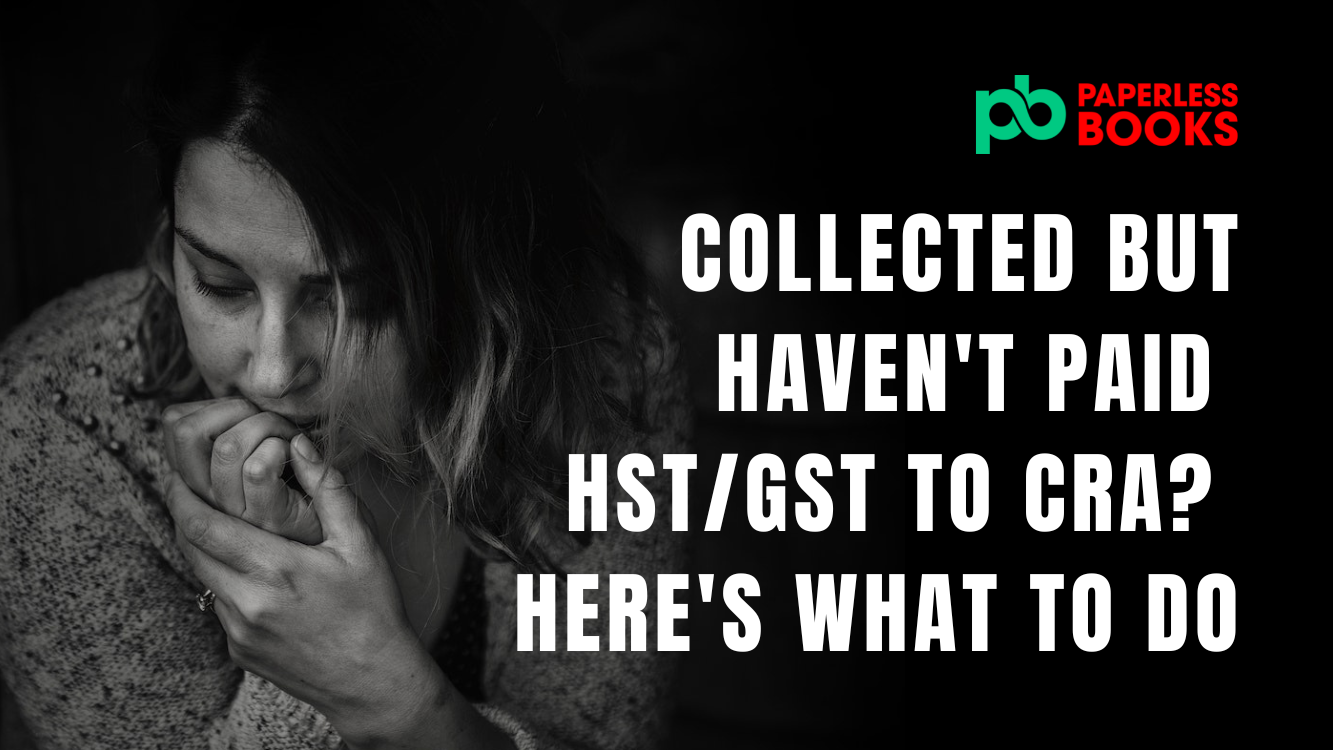Most thriving businesses in Canada are required to collect HST/GST at some point on their business journey. Typically, most business owners remember to collect HST/GST but a lot of businesses forget to pay or remit to the CRA either because they don’t know how or they have forgotten. If you have collected HST/GST from customers but have not paid HST/GST to Canada Revenue Agency (CRA), here is what to do.
In this blog, I will discuss frequently asked questions on what to do if you have not paid HST/GST to CRA in Canada. The following topics will be covered:
- Requirements for collecting HST/GST
- Consequences for not paying HST/GST to CRA
- Relief for registering or paying HST/GST late
- How to register for HST/GST
- Getting expert help to sort out HST/GST issues
Were You Required to Collect HST/GST In the First Place?
Depending on where you are on your business journey, you may not have been required to collect HST/GST in the first place.
There are certain thresholds that must be met in order to register for the GST/HST. If your business has worldwide taxable supplies (including zero-rated supplies) that exceed $30,000 in a single calendar quarter or in four consecutive calendar quarters, you are required to register GST/HST. If your business is a charity, the threshold is $50,000 in a single calendar quarter or in four consecutive calendar quarters.
If you are registered for GST/HST, you are required to charge and collect the tax on taxable supplies (other than zero-rated supplies) that you make in Canada. You are also required to file periodic GST/HST returns and remit the tax that you have collected to the CRA.
If you are not yet registered for HST/GST, it is important to do so immediately in order to prevent any interest or late fee penalties when it comes time to file and pay.
It is important to note that there are some exceptions to the registration requirements, and certain types of businesses may be eligible for special GST/HST registration rules. If you are unsure whether you are required to register for the GST/HST, you should contact the CRA for more information.
I Was Not Required to Collect HST/GST but I Still Did, Now What?
If you were NOT required to collect HST/GST based on the criteria above but you still did, you still have to register and remit what was collected to the CRA. This is because some businesses have to claim the HST/GST that they paid for and CRA has to match the GST/HST paid to the business that collected it. Failure to remit HST/GST can have serious implications if you were ever audited by the CRA.
In this situation, since you don’t meet the criteria above, you have to voluntarily register for an HST/GST account. Note that CRA allows you to have a registration date up to one month prior to the current date. If you were collecting HST/GST for more than 1 month prior to the registration date, you will have to send a letter to the CRA to adjust your registration date to meet the time in which you started collecting HST/GST. This process also applies to those who were required to collect HST/GST but registered more than 1 month after being required to registered and collect.
What Happens If You Don’t Pay Your HST/GST on Time or At All?
So what is the penalty for unpaid GST/HST? Not paying HST/GST on time or at all can have serious consequences for a business. The government may impose fines and penalties for late or missed payments, and the business may be subject to audits and investigations. In extreme cases, the business may even face criminal charges for tax evasion. In addition to these legal consequences, not paying HST/GST can also damage the business’s reputation and credibility with customers, suppliers, and other stakeholders. It can also affect the business’s ability to secure loans, credit, and other financial support in the future.
Is There Any Relief for Remitting HST/GST Late?
The CRA does offer some relief for those who collect HST/GST and miss to make payments with the help of the Voluntary Disclosure Program. The Voluntary Disclosures Program (VDP) grants relief on a case by case basis to taxpayers and registrants who voluntarily come forward to fix errors or omissions in their tax filings before CRA knows or contacts them about it. With this program, you can plead your case as to why you have not remitted your HST/GST to the CRA. The CRA in turn, may grant relief for not remitting your GST/HST on time.
Anyone looking for HST/GST relief can apply for the program however not everyone gets approved.
The most common situations that are applicable to this program include:
- undisclosed tax liabilities
- not charging, collecting, or reporting GST/HST for any reporting period
- claiming ineligible input tax credits, refunds or rebates
- providing incomplete information on a return for a reporting period
- not filing an information return
Applicants of the program get put into 1 of 3 categories on a case-by-case scenario. This includes the The Wash Transaction Program, The General Program or the Limited Program.
The Wash Transaction program is for those who failed to charge and collect GST/HST from a registrant who is entitled to a full input tax credit.
The General Program is intended for registrants who come forward to correct unintentional and reasonable errors.
The Limited Program is for registrants who intentionally avoided their tax obligations.
Various factors are considered in determining which program were case is best suited in. Getting approved for a Voluntary Disclosure Program typically means you can avoid criminal persecution but it may not void all late fee or penalty charges depending on your case.
For more information on getting relief for GST/HST payments owed, contact CRA or visit Canada.ca.
How Do I Register for HST/GST Number?
If you are ready to register for HST/GST, you can do so completely online on at Canada.ca.
Here are the steps involved in registering for an account so that you can file and pay for your HST/GST
- Determine if the business is required to register for HST/GST. In most cases, businesses with annual taxable sales of more than $30,000 must register for HST/GST. However, there are some exceptions, so it’s important to check with the government’s tax agency to determine the specific requirements.
- Gather the necessary documentation. To register for HST/GST, a business will need to provide proof of its legal name, business address, and contact information. It may also need to provide proof of its business activities, such as a business license or registration certificate.
- Complete the HST/GST registration form. This form can usually be found on the government’s tax agency website or obtained from a local tax office. The business will need to provide information about its business structure, contact information, and taxable activities.
- Visit this link: https://www.canada.ca/en/revenue-agency/services/tax/businesses/topics/registering-your-business/bro-register.html
- Click Register, and complete and follow the prompts
- When asked for an effective date, select a date as far back as possible.
- If asked to choose a filing period, choose yearly.
- If asked to enter any sales figures, enter 0.
- Submit the HST/GST registration form
- Wait for approval. Once the HST/GST registration form and supporting documentation have been submitted, the business will need to wait for approval. This process can take several weeks, so it’s important to plan ahead.
- Start collecting HST/GST. Once the business has been approved for HST/GST registration, it must start collecting HST/GST on all taxable sales. This includes charging HST/GST to customers and including it on invoices and receipts. The business will also need to keep track of all HST/GST collected and report it to the government on a regular basis.
Getting Expert Help if You Have Not Paid HST/GST
If you are trying to figure out what to do with your unpaid HST/GST, it is best to contact a bookkeeper or accountant, immediately.
Paperless Books can answer all your questions regarding HST/GST registration, collection, filing and payments.
Book a free 1 hour consultation below:


